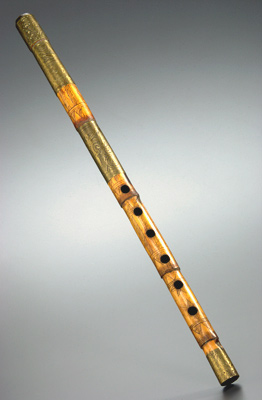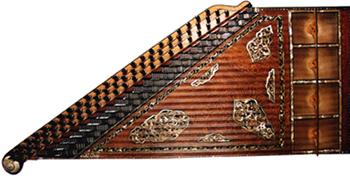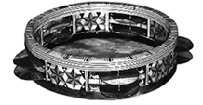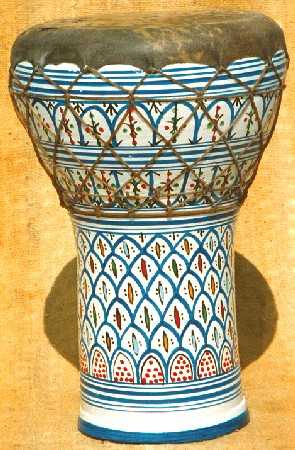![]()
ABOUT the instruments of the Arab Classical Music Society
|
 Buzuq
(long-necked lute), is found in both folk and urban contexts throughout
the Levant and especially played by Gypsies. It comes usually with
two or three double courses and a variable number of movable frets.
Its metal strings produce a bright sound and are well suited for
drone effects. In recent years, several Palestinian groups integrated
the instrument in the classical takht as part of a growing interest
in exploring its possibilities. See National
Conservatory of Music, Palestine. Buzuq
(long-necked lute), is found in both folk and urban contexts throughout
the Levant and especially played by Gypsies. It comes usually with
two or three double courses and a variable number of movable frets.
Its metal strings produce a bright sound and are well suited for
drone effects. In recent years, several Palestinian groups integrated
the instrument in the classical takht as part of a growing interest
in exploring its possibilities. See National
Conservatory of Music, Palestine. |
 Nay,
is an urban instrument and the only wind instrument used in Arab
classical music. It appears alongside the '?d (lute), the qanun,
the daff and the darbukkah. Itâs an open tube that has six
finger-holes in front and one thumb-hole in the back. The edge
of the tube at the top is lightly bevelled. Nay varies in
length and each one is designated by the name of its fundamental
note (given by opening the first hole): nay Mahur (C), nay Dukah
(D), nay Buselik (E), nay Chargah (F), nay Nawa (G), nay Husayni
(A), nay 'Ajam (B ), nay Kardan (c), and so on. Nay,
is an urban instrument and the only wind instrument used in Arab
classical music. It appears alongside the '?d (lute), the qanun,
the daff and the darbukkah. Itâs an open tube that has six
finger-holes in front and one thumb-hole in the back. The edge
of the tube at the top is lightly bevelled. Nay varies in
length and each one is designated by the name of its fundamental
note (given by opening the first hole): nay Mahur (C), nay Dukah
(D), nay Buselik (E), nay Chargah (F), nay Nawa (G), nay Husayni
(A), nay 'Ajam (B ), nay Kardan (c), and so on. |
 Qanun,
is one of the classical instruments of the Arab world, known in
both oral and written traditions. It is the plucked box zither
or psaltery of the Middle East. On the modern Arab q?n?n, there
are two to five levers for every string (in triples). Intervals
can be minutely adjusted by rotating the levers, which control
the tension of the strings; this permits a full range of keys.
Arab performers play in octaves or double octaves. The right hand
is notated in the treble clef and the left in the bass. Qanun,
is one of the classical instruments of the Arab world, known in
both oral and written traditions. It is the plucked box zither
or psaltery of the Middle East. On the modern Arab q?n?n, there
are two to five levers for every string (in triples). Intervals
can be minutely adjusted by rotating the levers, which control
the tension of the strings; this permits a full range of keys.
Arab performers play in octaves or double octaves. The right hand
is notated in the treble clef and the left in the bass. |
 Riqq,
is a small, circular frame drum with jingles. It is dominantly
used in North Africa, Iraq, the Levant and Sudan. It is between
20 and 25 cm in diameter and is played in takht ensembles of Egypt,
Syria or Iraq where it goes beyond the simple rhythmic requirements
of the other percussion instruments in terms of ornamentation
and color. Riqq,
is a small, circular frame drum with jingles. It is dominantly
used in North Africa, Iraq, the Levant and Sudan. It is between
20 and 25 cm in diameter and is played in takht ensembles of Egypt,
Syria or Iraq where it goes beyond the simple rhythmic requirements
of the other percussion instruments in terms of ornamentation
and color. |
 Darbukka,
a single-headed goblet drum. It is made from pottery, wood or metal;
the bottom is open and the skin head is directly attached by nails,
glue or binding. It is found in a range of sizes, particularly
in North Africa, where several may be played together in ensembles.The
origin of the term darabukka is somewhat obscure but probably lies
in the Arabic word darba (to strike), or durub (rhythmic cycles),
darbukka could mean, therefore, your strike, or your rhythm. Darbukka,
a single-headed goblet drum. It is made from pottery, wood or metal;
the bottom is open and the skin head is directly attached by nails,
glue or binding. It is found in a range of sizes, particularly
in North Africa, where several may be played together in ensembles.The
origin of the term darabukka is somewhat obscure but probably lies
in the Arabic word darba (to strike), or durub (rhythmic cycles),
darbukka could mean, therefore, your strike, or your rhythm. |
